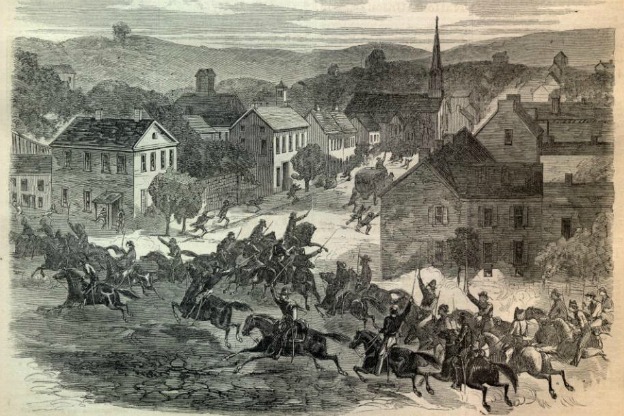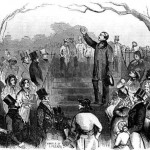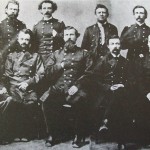During the Civil War, rumors flew in Indiana, as they did elsewhere in the North, that certain parts of the state were full of Copperheads–Southern sympathizers who, it was widely believed, were not only opposed to the president and the war but who were actively working for the defeat of the Union.
Letters and memoirs, as well as official documents from the period, have proven that there were indeed many Copperheads in Indiana. More disputed, however, is whether any of these Southern sympathizers took their disagreement further into plans for the violent overthrow of the state government—plans that were said to be hatched in secret meetings of a society known as the Knights of the Golden Circle.
The Knights of the Golden Circle had been organized in the late 1850s and were said to be dedicated to preserving the slave states and to establishing a new slave empire in Mexico. By 1863, Indiana Governor Oliver Morton was convinced that these secret societies were forming in his state. Morton accused the state’s anti-war Democrats, who opposed many of Lincoln’s policies and still favored reconciliation with the South, of trying to set up a “Northwest Confederacy” in Indiana. Morton and other Republicans blamed the Knights for aiding and encouraging deserters and for a lag in the recruitment of volunteers. Morton also suspected that Morgan’s Raid had been planned “to coincide with an uprising of the Golden Circle” .
Was Morton correct, or were his charges a combination of war-time paranoia and convenient politics? Beginning in the 1960s, historian Frank Klement wrote books and articles claiming that the Knights were almost entirely a fiction. More recently, historian Jennifer Weber, who has studied the Copperheads across the North, says that historians “cannot dismiss” the sizable correspondence that proposes violent action against Northern interests. One story that may give support to Weber, and to Morton’s claims from the 1860s, comes from Florence L. Grayston, of Huntington, Indiana.
In the 1940s, Grayston wrote about a story her father had told her from his own childhood. One night a group of men came to the door asking for his father, a local doctor. The doctor was blindfolded by the men and put into their wagon. He later told the story of the night’s events to his sons. After a long drive, they arrived at a barn where two masked men lay injured—one had a broken leg and the other had been shot in the hip. The doctor attended his patients, being warned several times to tell no-one of what had occurred.
Later, in relating the story to his sons, the doctor told them that he had recognized at least one of the wounded men and others in the group as local acquaintances and friends and as members of the Knights of the Golden Circle. He remarked that “if the roll of membership of the Knights should ever be published many people might be surprised.” Florence Grayston recounted that her father would be “covered with goose pimples” when he told the story to her and that she, in turn, had “cold shivers down my spine” whenever she heard about the Knights.
We will never be certain as to whether Florence’s grandfather had an encounter with the Knights, but historians are increasingly convinced that there were Hoosiers among their membership, plotting to overthrow Indiana Governor Morton and Abraham Lincoln.
A Moment of Indiana History is a production of WFIU Public Radio in partnership with the Indiana Public Broadcasting Stations. Research support comes from Indiana Magazine of History published by the Indiana University Department of History.
IMH Source Articles:
- Frank L. Klement, “Carrington and the Golden Circle Legend in Indiana during the Civil War,” Indiana Magazine of History 61 (Mar. 1965): 31-52.
- Florence L. Grayston, “Lambdin P. Milligan—A Knight of the Golden Circle,” Indiana Magazine of History 43 (Dec. 1947): 379-391.























